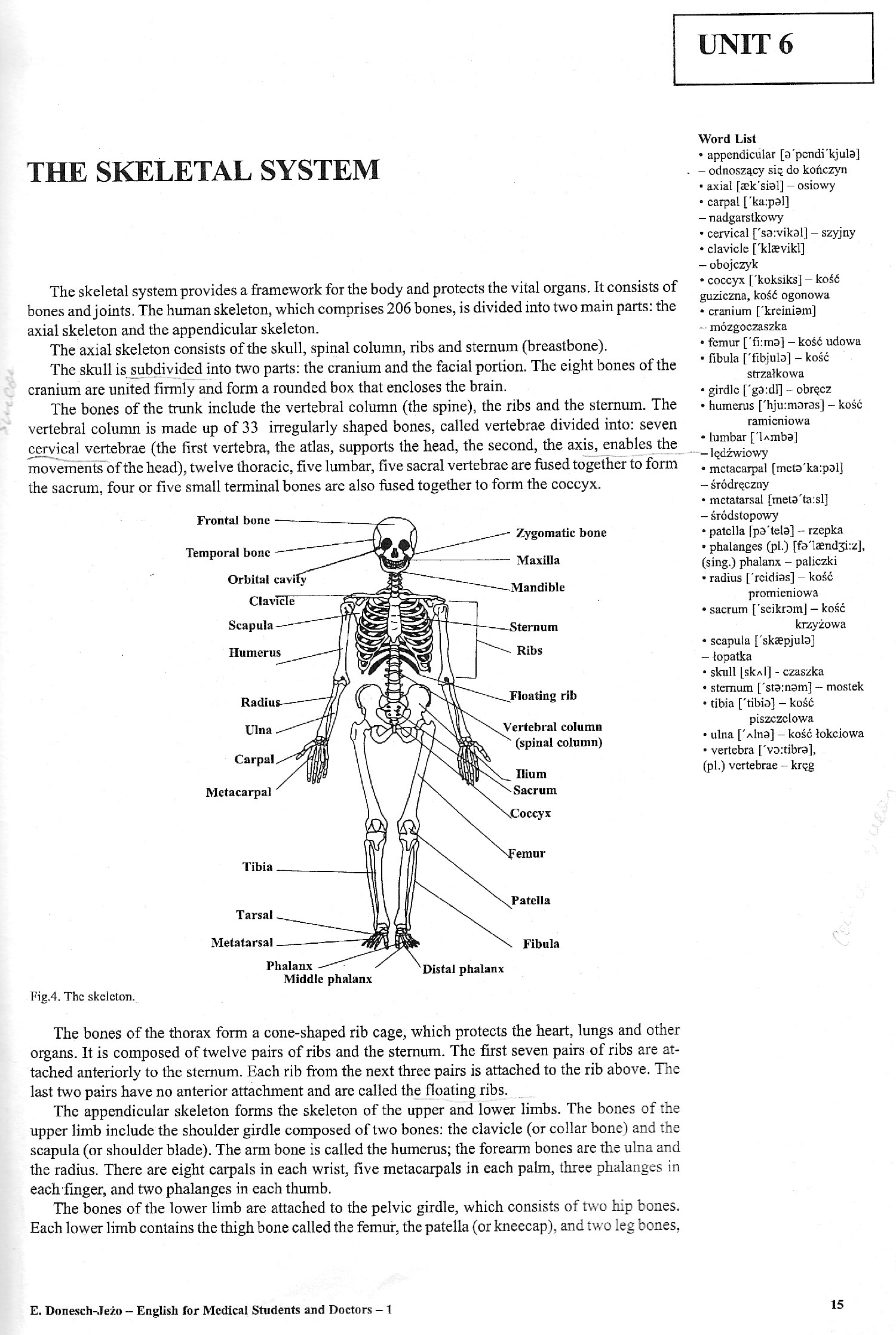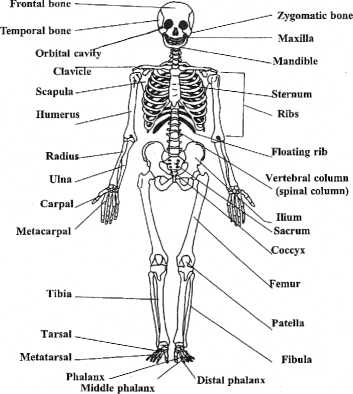15

THE SKELETAL SYSTEM
The skeletal system provides a framework for the body and protects the vital organs. It consists of bones and joints. The human skeleton, which comprises 206 bones, is divided into t\vo main parts: the axial skeleton and the appendicular skeleton.
The axial skeleton consists of the skuli, spinał column, ribs and stemum (breastbone).
The skuli is subdiyided into two parts: the cranium and the facial portion. The eight bones of the cranium are United firmly and form a rounded box that encloses the brain.
The bones of the trunk include the vertebral column (the spine), the ribs and the stemum. The vertebral column is madę up of 33 irregularly shaped bones, called vertebrae divided into: seven cervical vertebrae (the first vertebra, the atlas, supports the head, the second, the axis, enables the movements of the head), twelve thoracic, five lumbar, five sacral vertebrae are fused together to form the sacrum, four or five smali terminal bones are also fused together to form the coccyx.

Fig.4. The skeleton.
The bones of the thorax form a cone-shaped rib cage, which protects the heart, lungs and other organs. It is composed of twelve pairs of ribs and the stemum. The first seven pairs of ribs are at-tached anteriorly to the stemum. Each rib from the next three pairs is attached to the rib above. The last two pairs have no anterior attachment and are called the floating ribs.
The appendicular skeleton fonns the skeleton of the upper and lower limbs. The bones of the upper limb include the shoulder girdle composed of two bones: the clavicle (or collar bonę) and the scapula (or shoulder blade). The arm bonę is called the humerus; the forearm bones are the ulna and the radius. There are eight carpals in each wrist, five metacarpals in each palm, three phalanges in eacłrfinger, and two phalanges in each thumb.
The bones of the lower limb are attached to the pelvic girdle, which consists of two hip bones. Each lower limb contains the thigh bonę called the femur, the patella (or kneecap), and two leg bones,
E. Donesch-Jeżo — English for Medical Students and Doctors -1
Word List
• appendicular [3'pcndi'kjula]
- odnoszący się do kończyn
• axial [$k'siol] - osiowy
• carpal [*ka:p9l]
- nadgarstkowy
• cervical ['sa:viksl] - szyjny »clavicle ['klaevikl]
- obojczyk
• coccyx ['koksiks] - kość guziczna, kość ogonowa
• cranium ['kreiniam]
- mózgoczaszka
• femur ['fi: ma] - kość udowa
• fibula [Tlbjub] - kość
strzałkowa
• girdlc ['ga:dl] - obręcz
• humerus ['hju:moras] - kość
ramieniowa
• łumbar ['Umba]
- lędźwiowy
• mctacarpal [meta'ka:palj
- śródręczny
• metatarsai [meta'ta:sl]
- śródstopowy
■ patclla [pa'tela] - rzepka
• phalanges (pl.) [fbTaendgkz], (sing.) phalanx - paliczki
• radius [Tcidias] - kość
promieniowa
• sacrum ['seikramj - kość
krzyżowa
• scapula ['skspjula]
- łopatka
■ skuli [skAl] - czaszka
• stemum [’sta:nam] - mostek
• tibia ['tibia] - kość
piszczelowa
• ulna ['Alna] - kość łokciowa
• vertebra ['va:tibra],
(pl.) vcrtebrae - kręg
15
Wyszukiwarka
Podobne podstrony:
52763 mbs 074 MY BREATHING SYSTEM respect. may in reality prove harmful to the vital organs of indiv
TłheStrong enough to protect our vital organs, intricately structured to keep the body upright and
1.3.1 The basie design activities in CAD Systems The CAD system provides generally the following des
UNIT 7THE RESPIRATORY SYSTEM The respiratory system (RS) is Tesponsible for carrying oxygen from the
skanuj0003 The main functions of a financial system 2. providing the means of paym
Types/categories of work The types of work for which P.T.W. systems are normally applied include mai
mbs 027 MY BREATHING SYSTEM sucked in. For persons who lind it very difficult to acquire tłiis contr
Replication and Time Zones The same system time zonę should be set for both master and slave. Otherw
System reset (cluster reset). To reset the cluster because it has reached an undesirable State. In s
72688 system 52 A PROGRAMME FOR THE FIRST SIX WEEKS AU beginners, strong boys and sturdy men include
mbs 019 MY BREATHDfG SYSTEM exlialation than during inhalation. The lungs strongcr, it is an excelle
4. A new relationship to the site, for the community and its water systems:creates a place for every
50424 IMG 35 (2) FImiiImH UaLa m< ił,_______« . .iequirea tasKs ot me mucossi immune system 1. &n
więcej podobnych podstron